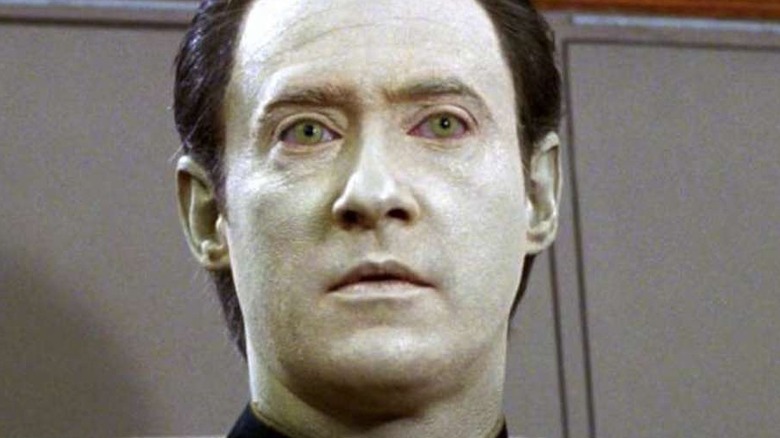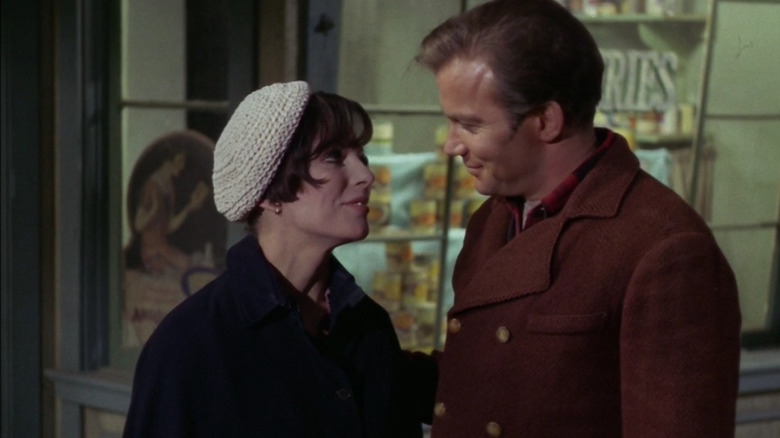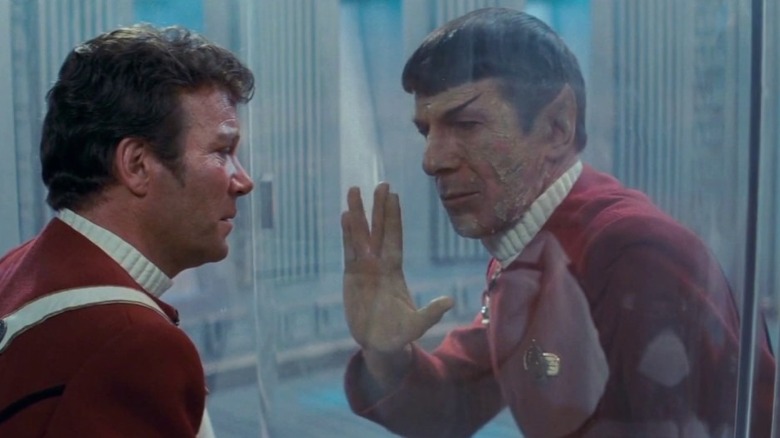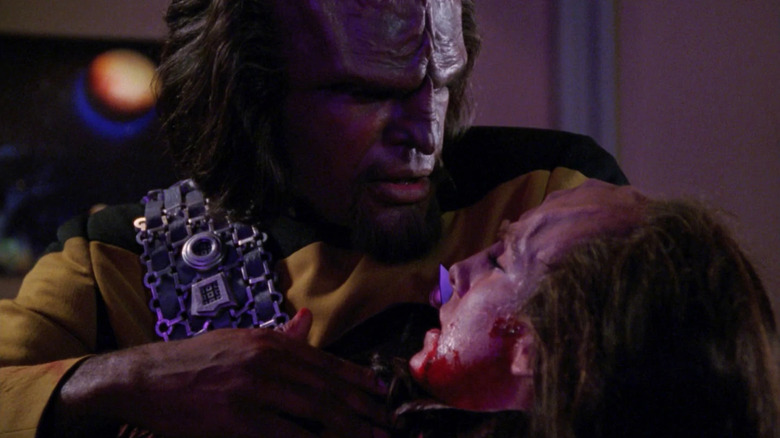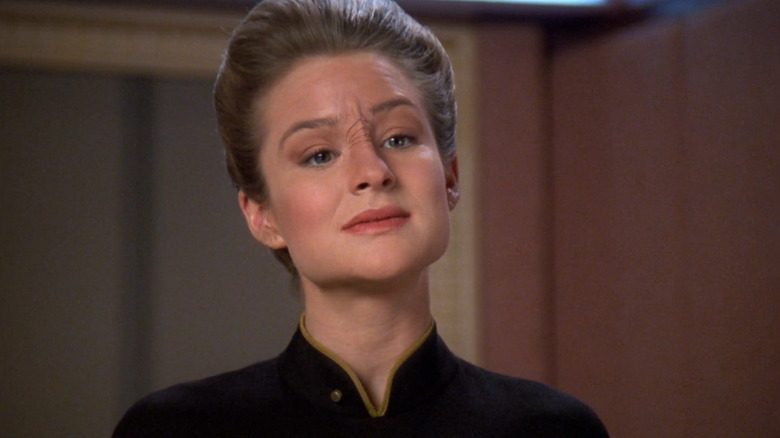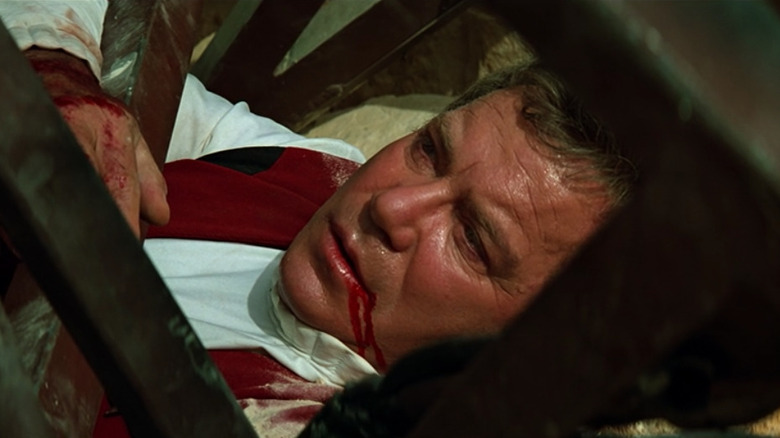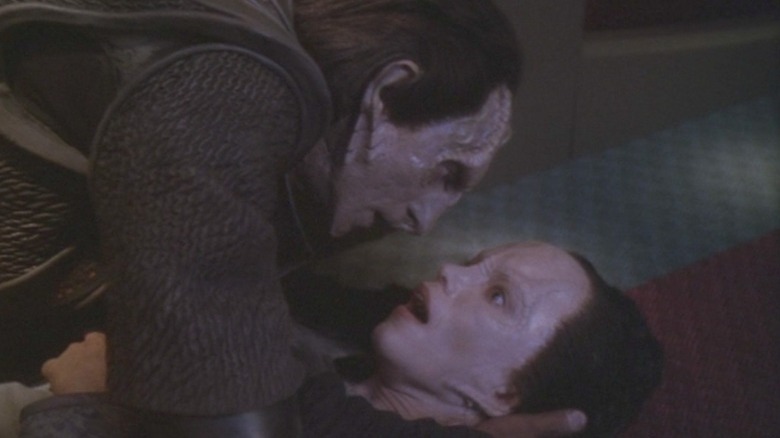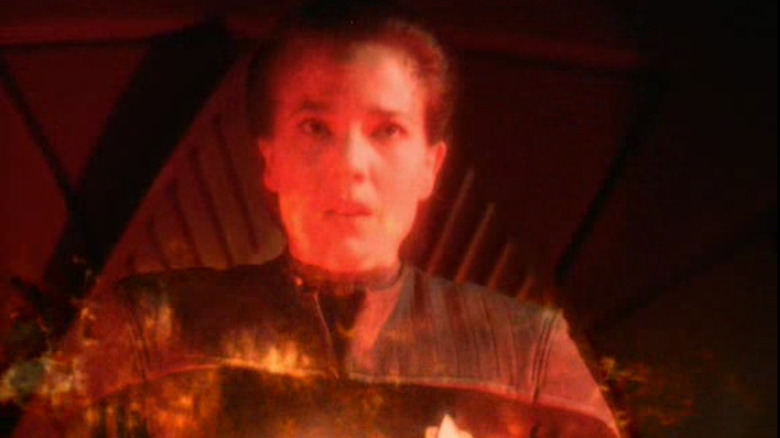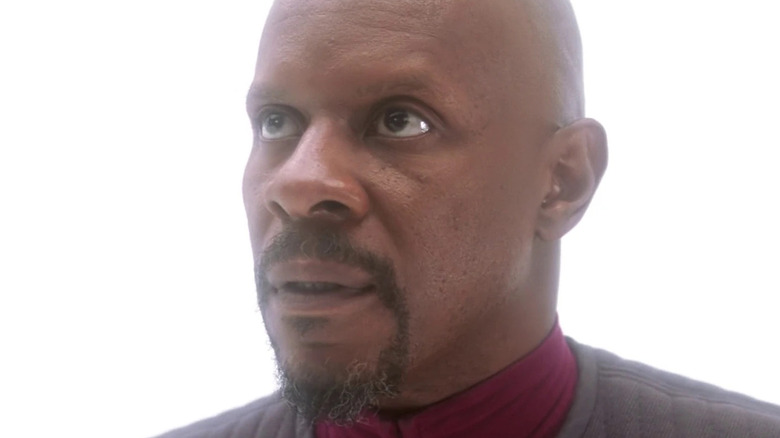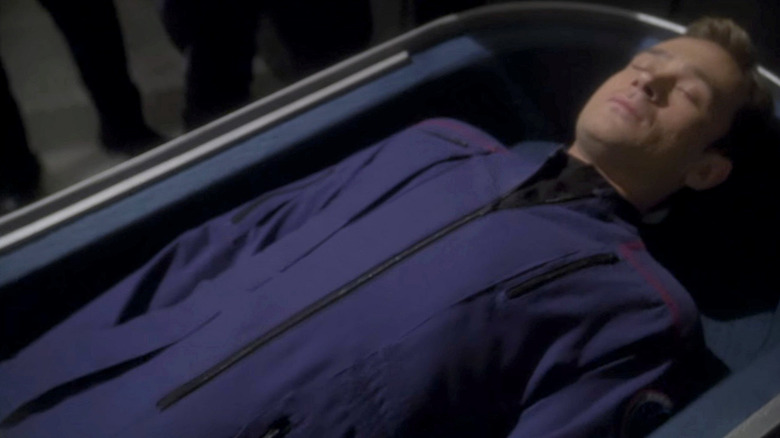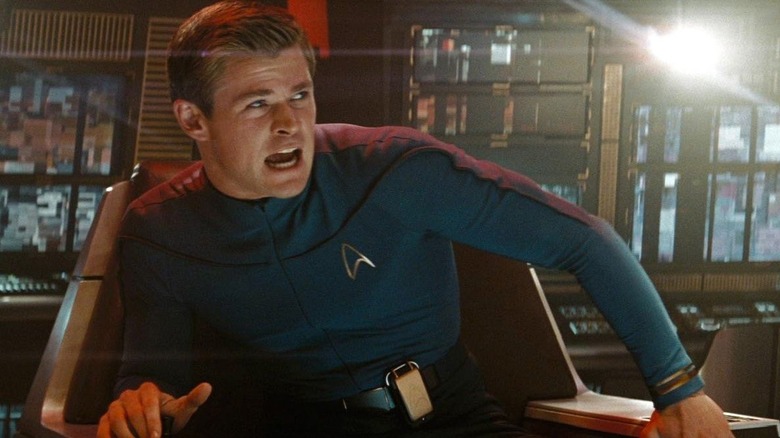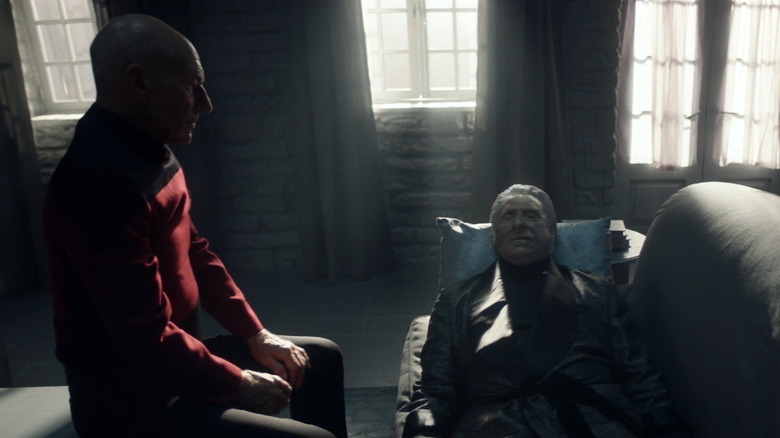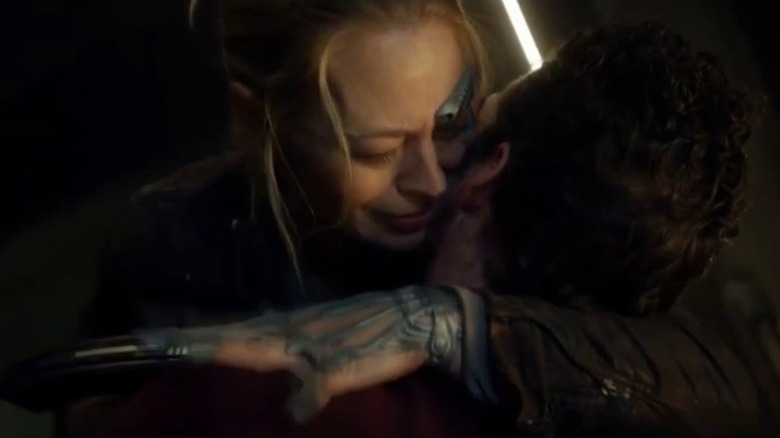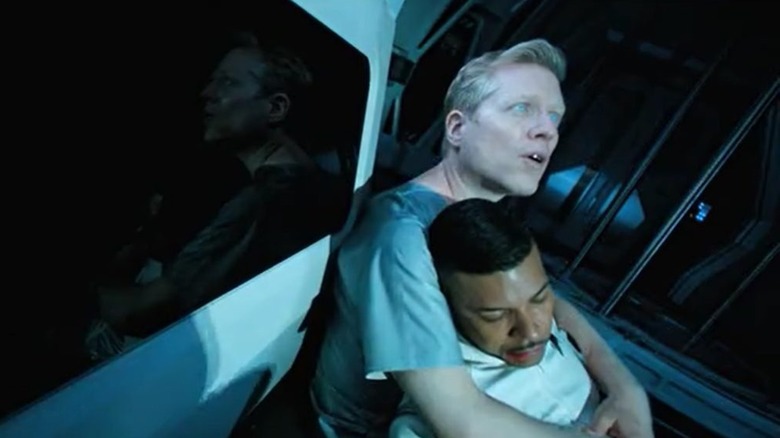The Most Devastating Deaths In The Star Trek Franchise
Spanning nearly 60 years, nearly a dozen TV series and 13 feature films, "Star Trek" has had its fair share of stunning surprises, nail-biting climaxes, and adrenaline-pumping excitement. From its earliest days in the 1960s when Captain Kirk led the way to the newest episodes of "Star Trek: Discovery" set in the 32nd century, the franchise's intrepid explorers have faced down all kinds of enemies, solved perplexing problems, and explored those strange new worlds.
Though "Star Trek" has been known for its optimism and sense of pioneering adventure, going toe-to-toe with the Klingons, the Borg, and the Cardassians hasn't been without consequences. While it's not a franchise known for killing off its cast members with the kind of wild abandon seen on "The Walking Dead" or "Game Of Thrones," it's not been without its gut-wrenching losses either. But thanks to its optimistic nature, almost every loss is felt in "Star Trek," whether it was a one-time guest star or a beloved franchise favorite.
Some deaths we may have seen coming, but were no less traumatic, while others were shocking and unexpected. From 1966 to today, we've taken a look back at the most devastating deaths we've seen in the "Star Trek" franchise. Here's a list of the ones that moved us the most, and reminded us that every life is precious.
Edith Keeler
In the classic 1966 "Star Trek" episode "The City On The Edge Of Forever," the Enterprise visits a deserted world where an ancient portal can allow travel into the past. A sick Dr. McCoy inadvertently passes through it and changes history so that the Enterprise never existed, forcing Kirk and Spock to follow him back and fix the timeline. Finding themselves in the middle of the Great Depression, the duo spend months looking for McCoy, and during their search they get help from a woman named Edith Keeler, who runs a homeless shelter there.
While Spock is looking for McCoy and trying to discover just what event caused history to be altered, Kirk gets to know Keeler and the two begin to fall in love. But matters are complicated when Spock learns that in order to fix the timeline, they must restore a history where Edith Keeler died in a fateful car accident. Even knowing what must be, Kirk continues his relationship with Keeler. In the end, however, it's Kirk who stops McCoy from saving her when she is struck by a car while crossing the street. Devastated, Kirk is forced to sacrifice the woman he loves to save all of humanity — a powerful ending to what is often considered the best "Star Trek" episode ever.
Spock
"Star Trek II: The Wrath Of Khan" is a classic for many reasons, including its brilliant villain, its dramatic climax, and of course, the death of Mr. Spock. After the release of "Star Trek: The Motion Picture" in 1979, actor Leonard Nimoy made it clear to producers he wasn't enthusiastic about returning to play Spock again. But they were able to get him back for one more, thanks to a terrific script. "Leonard was very ambivalent about doing another 'Star Trek' movie," said "Wrath of Khan" director Nicholas Meyer. "[Producer] Harve Bennett lured him with the promise of a terrific death scene, which (Shatner) and he played so touchingly."
In the film, the Enterprise is locked in combat with Khan's stolen Starfleet ship, the USS Reliant, and the ship's engine is damaged. Spock heads down to the engine room to fix the problem, but to do so he must enter the engine core itself, an act that will kill him with deadly radiation. He saves the ship, and gives one final emotional speech to Captain Kirk, uttering the immortal words, "I have been, and always shall be, your friend."
Thankfully, a change of heart on Nimoy's part during filming led to reshoots that set up his return in the follow-up film, "Star Trek III: The Search For Spock." But at the time, his death was a first for Trekkies, who had to watch a beloved and iconic character die before their eyes, while Captain Kirk was helpless to save him.
K'Ehleyr
Introduced in the "Star Trek: The Next Generation" second season episode "The Emissary," the half-human, half-Klingon K'Ehleyr was a special Federation Emissary brought on board in a crisis involving a derelict Klingon ship. A former lover of Klingon Security Chief Lieutenant Worf, the pair rekindle their physical relationship during the mission. Worf is left jilted, however, when K'Ehleyr refuses to commit to him in a Klingon bonding ritual.
Just one year later in "Reunion," K'Ehleyr returns when the Klingon Chancellor K'Empec is on his deathbed, and she doesn't come alone. With her is her son, Alexander, the child Worf sired with her when they had last met. But when K'Ehleyr investigates the matter at hand she becomes the target of the villainous Klingon named Duras. When her digging gets too close to the truth of Duras' treachery, K'Ehleyr winds up on the wrong end of Duras' blade. With her dying breath K'Ehleyr reveals to Alexander that Worf is his father, as Worf cradles her in his arms. Worf then let out a ritualistic death roar that's overflowing with rage and grief for his lost love.
Worf gets his revenge on Duras, but K'Ehleyr's death would mark a major turning point in Worf's story. It gave him a son in Alexander, who would go on to play a substantial supporting role in the series and provide a tragic past that would forever help define his character.
Ensign Sito Jaxa
Though not a major character on "Star Trek," the young Bajoran officer Ensign Sito Jaxa, like Edith Keeler, made an impression on audiences with her wide-eyed optimism and soulful personality. Her first appearance came in the fourth season episode of "Star Trek: The Next Generation" titled "The First Duty," in which she got caught up in a scandal at Starfleet Academy to cover up the death of a fellow cadet. She would make a surprise return in the Season 7 episode "Lower Decks," where she was now assigned to the Enterprise and up for a promotion.
A relatively light-hearted affair, the episode revolves almost entirely around the lives of four young officers aboard the Enterprise during their crew evaluations, in an offbeat episode that took the spotlight off the main cast. But during the episode, a Cardassian double agent arrives looking for safe passage back home after a debriefing, and Jaxa is recruited by Captain Picard to help. Pretending to be a Bajoran prisoner, she will make his trip more believable, with him posing as a returning bounty hunter.
At the conclusion of the story however, it's revealed that the plan to return Jaxa to the Enterprise fails, and the young officer is killed by a Cardassian patrol. It's a grim, dark ending to what was otherwise an upbeat episode, and a devastating end to what was a promising new character.
Captain James T. Kirk
The first feature film starring the cast of "Star Trek: The Next Generation" was designed to be a "passing of the baton" from the original "Star Trek," with Kirk, Scotty, and Chekov appearing at the beginning of the film as they christen the Enterprise-B, the first Enterprise with a new crew. But during their first voyage, disaster strikes when a strange space anomaly called the Nexus damages the ship and takes Kirk with it.
Nearly 100 years later, Captain Picard and the USS Enterprise-D are facing a villain named Soran, who is seeking to enter the Nexus himself, and threatens to destroy a planet to do it. When Picard is drawn into the anomaly he finds none other than his predecessor, Captain Kirk, still as he was a century earlier. Together, the two Enterprise captains work together to stop Soran in one of the most fan-pleasing team-ups in science fiction history. But Kirk is killed during the climax of the film, much to the dismay of the fandom.
While not the most well-received "Star Trek" movie, with Kirk's death receiving plenty of criticism, it's hard to deny the devastating impact it had on the fandom. Killing off the man who was arguably the biggest star in "Star Trek" stunned the audience, and was regretted almost instantly by star William Shatner, who has seemingly made it his personal mission to return to the role.
Tora Ziyal
Making her debut in the "Deep Space Nine" episode "Indiscretion," Tora Ziyal is the half-Bajoran, half-Cardassian daughter of the series' main villain, Gul Dukat. The product of an affair while he was the prefect of Bajor, Ziyal and her mother were sent to a neutral planet after the Cardassian Occupation came to an end. But their transport ship, the Ravinok, was lost after an attack by the Breen. Years later, evidence of the Ravinok's crash site surfaces, so Major Kira and Dukat mount a rescue mission and discover Ziyal alive.
Fearing his daughter's existence might threaten his powerful position in the Cardassian military, Dukat plans to kill Ziyal, but is talked out of it by Kira. Eventually, Ziyal forges a new relationship with her father, and comes to live aboard Deep Space Nine. She forms a sisterly bond with Kira, and even a romantic relationship with the enigmatic former spy Garak. But when the Dominion takes over the station, Ziyal helps the resistance fight back, defying her father. In the climactic moments of the two-part episode that sees Starfleet re-take the station, Dukat can't convince her to leave. In a shocking final twist, Dukat's top lieutenant Damar forces his hand by murdering Ziyal in cold blood.
Like Sito Jaxa, Ziyal was an upbeat, optimistic character, and one whose presence had added a warmth and earnestness to the series. Her death at Damar's hand did more than devastate the audience too, sending Dukat into a psychotic spiral and turning him from a powerful figure into a broken man.
Jadzia Dax
Following the sixth season of "Star Trek: Deep Space Nine," series mainstay Terry Farrell — who played science officer and joined Trill symbiont Jadzia Dax — was up for contract renewal. According the actress, she was told by producers to accept whatever offer was given because if she wasn't on "Deep Space Nine," she would be "working at K-Mart." Understandably frustrated, Farrell declined their offer. But rather than writing her out of the series to allow for guest appearances, the producers instead opted to kill off Jadzia Dax in a devastating season finale.
In the days before social media, most viewers who weren't aware of the behind-the-scenes drama were taken by surprise when Gul Dukat, the villainous Cardassian — now possessed by the spirit of the nefarious Pah Wraiths — murders Dax while she's visiting a Bajoran shrine to pray. With Daz recently married to longtime fan favorite Worf, the pair were hoping for a baby. The exit of one of the series' biggest characters, in the midst of such an emotional story, was a brutal heartbreaker for fans.
Thanks to the magic of science fiction of course, the Trill symbiont within her was given a new body, and actress Nicole De Boer replaced Farrell as a new version of Dax named Ezri. Still, the sudden loss of Jadzia was felt not just by Sisko and Worf, but by longtime fans as well.
Benjamin Sisko
Though not exactly a death per se, the series finale of "Deep Space Nine" did see the end of corporeal existence for the series' longtime captain, Benjamin Sisko. Having finally accepted his role as the Emissary of the Prophets, Sisko battles against their greatest enemies, the Pah Wraiths. Meanwhile Sisko's most insidious adversary, the Cardassian villain Gul Dukat, has been cast out by his own people, and embraces the Pah Wraiths as a way of getting revenge on his nemesis. In a final showdown in the Bajoran fire caves, the two have it out once and for all.
Though Sisko and the Prophets prevail, the captain's physical body is destroyed, and the crew of Deep Space Nine, the Bajoran people, and his wife and son all mourn his death. It's only in one of the final moments of the series' last episode that it's revealed that Sisko isn't gone, but has simply transcended his physical existence: he is now a Prophet himself. While Sisko vows to return one day, his wife Kasidy openly weeps in his arms before he disappears. The closing shot of the series finds Sisko's son Jake looking longingly out the window of the station in one of the show's most bittersweet moments.
It was the first time in "Trek" history that a series had ended with the death of a major character. Of course, Sisko is still out there somewhere and could theoretically return, though actor Avery Brooks hasn't performed on screen in more than 20 years.
Sim
Though some "Star Trek" fans point to the death of Charles "Trip" Tucker in the final "Enterprise" episode, "These Are The Voyages," there's another death of sorts for the character that looms much more devastating. A far more impactful story, the Season 3 episode "Similitude" saw Trip critically injured, and the ship's resident doctor cooking up an unusual cure. Using the genome of a rare species of larvae, they will create a clone of their chief engineer, and use it to harvest its brain tissue to save the original. Given that the new being will only have a lifespan of about two weeks, the plan is to let the clone live out its life and die naturally, thereby allaying most of their ethical concerns.
But their convictions are tested when the clone grows from a child to an adult aboard the ship in a matter of days, and begins to form friendships with the people aboard the Enterprise. Eventually the clone of Trip falls in love with T'Pol too, and quickly becomes a valued member of the crew. Eventually, "Sim," as he becomes known, is forced to confront the nature of his existence, while everyone around him must wrestle with the emotional consequences of their actions. While "Similitude" may have killed off a short-lived clone instead of a main character, the death of Sim was heartbreaking, with an emotional weight that Trip's actual death in the series finale lacked.
George Kirk
The "Star Trek" franchise was rebooted in 2009 by J.J. Abrams, and became the kind of fast-paced roller coaster ride the director had become famous for. But if there's one thing Abrams loves more than lens flares, it's tugging at an audience's heart strings in devastating emotional moments, and he did just that in the opening of his first "Star Trek" movie. The film begins aboard the USS Kelvin, a Federation starship that has just encountered a mysterious spatial anomaly, and out of it comes an enormous Romulan starship. After the Romulans kill his captain, first officer George Kirk — played by a then-unknown Chris Hemsworth — takes command and attempts to fight off the enemy ship.
But the battle does not go well, and Lieutenant Commander Kirk, whose wife is about to go into labor in sickbay, orders all hands to abandon ship, while he stays behind to pilot the Kelvin. Having lost their auto pilot, he realizes the only way to save his crew is to set a collision course with the Romulan vessel. The last man on the bridge, Kirk calls to his wife aboard a shuttle, and tells her an emotional goodbye. With the bridge falling apart around him, the husband and wife pick out a name for their son — James Tiberius Kirk — and he tells her he loves her just as the two ships collide in a massive fireball.
Despite only knowing the elder Kirk for a matter of moments, his death is a devastating gut punch for audiences to start the film.
Data
It's somewhat ironic that this next entry on our list is the death of an already dead character, as the entire first season of "Star Trek: Picard" had the former Enterprise captain still mourning the loss of his old friend Commander Data. Killed in a final confrontation with the Romulan villain Shinzon in the last "Next Generation" film, 2002's "Star Trek: Nemesis," Data returns in the revived series thanks once again to the magic of science fiction. Using a form of fractal neuronic cloning, Professor Bruce Maddox is able to keep Data's memories alive within an elaborate quantum simulation, and in the series' final episode, Picard comes face to face with his old friend.
In the finale, "Et in Arcadia Ego, Part 2," Picard enters the simulation himself and there Data asks him to end his life, as only his death can give his existence meaning. Picard agrees, and the two share a quiet moment as Data sips a glass of wine, before laying down and passing away. It's perhaps one of the most emotionally heart-rending deaths in the franchise: while he had technically died once before, this more conclusive ending was far more devastating, as we had just gotten used to seeing Data again after a nearly 20-year absence.
Icheb
A holdover from "Star Trek: Voyager," the character of Icheb made a surprise appearance in the "Star Trek: Picard" episode "Stardust City Rag" in a flashback to Seven of Nine's days before joining up with the Enterprise captain. But the ex-Borg's return was short-lived, as it was revealed that it was his death that motivated Seven Of Nine's vendetta against the villain Bjayzl.
Found by Captain Janeway and the starship Voyager aboard a damaged Borg vessel in the sixth season of "Voyager," Icheb and several other Borg children were eventually taken aboard the ship and disconnected from the collective just as Seven Of Nine had been. While the others were returned to their people, Icheb's tragedy was compounded when it was revealed that his parents had bred him as a living weapon against the cybernetic tyrants. Ultimately Icheb would remain on Voyager and return with them to Earth in the series finale. It's later shown that Icheb joined Starfleet, but in "Stardust City Rag" we're shown his grisly end.
Abducted by Bjayzyl so she could harvest his remaining Borg implants, Icheb is ripped apart in an intense and graphic torture scene. Bjayzel is searching for his cortical node, which as it turns out, had been removed and given to Seven Of Nine years before. After Icheb's death, Seven would never be the same, and neither would audiences, many of whom felt that Icheb's graphic death scene had gone too far for "Star Trek."
Hugh Culber
"Star Trek: Discovery," the first "Trek" series in more than a decade, was a new beginning for the franchise. It set itself apart in a number of ways from its predecessors, from its darker tone to its big-budget action. But it was also the first "Star Trek" series to include not just one, but two LGBTQ cast members: Commander Paul Stamets (Anthony Rapp) and Chief Medical Officer Hugh Culber (Wilson Cruz) were the first gay cast members in "Star Trek" history, living together on the ship as a committed couple.
That's why it came as such a shock when at the end of the first season, Culber was brutally murdered. After crewmate Ash Tyler begins to believe that he's suffering from some kind of traumatic repressed memory, he goes to Culber for help. Culber discovers that Tyler isn't human at all, and has been surgically altered, with a new personality — that of a Starfleet officer — implanted on top of his real identity. The revelation triggers Tyler's real persona — that of the vicious Klingon messiah Voq — who promptly breaks Culber's neck.
While some critics have knocked the death of Hugh Culber as an example of the unfortunate trope of killing off a gay character (via Daily Dot), it's hard to argue that it was anything less than one of the season's most devastating moments. Thankfully, "Star Trek: Discovery" brought Culber back the next season, and he's since followed the crew of Discovery into the 32nd century where he and Stamets remain a happy couple.
